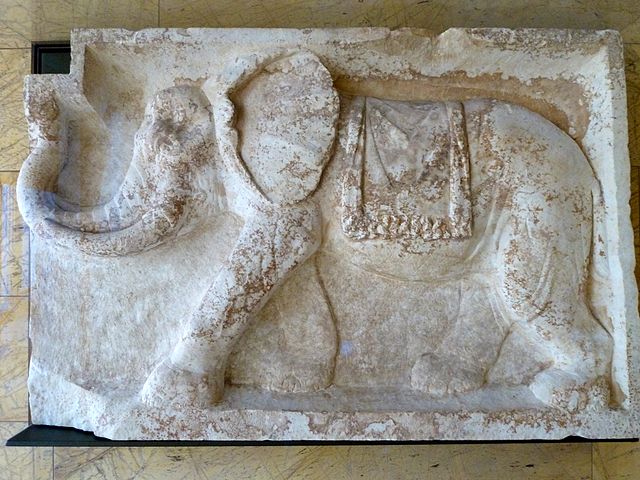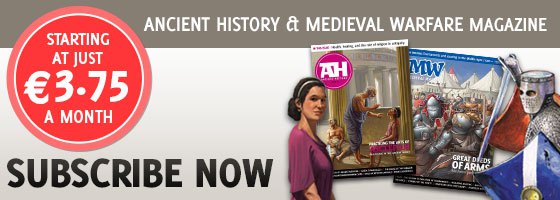Bestiary of Battle: Animals and Warfare in the Roman World
By Haley Flagg
Graduate Student Paper, 2015

Introduction: Mankind has always excelled at manipulating natural resources for violent use – metals become weapons, the landscape becomes a battle plan, and animals become instruments of war. The Romans were not the first or the last to employ animals in the arena of human violence, but owing to the vastness of the Roman sphere of influence, the diversity of conditions led to the interaction with and incorporation of numerous war animals. Unfortunately, direct archaeological evidence is often lacking, as the remains of animals killed in warfare, like human remains, are rare discoveries. Literary and artistic sources are often the only means of interpreting the use of certain species in the Roman military. These sources are at least indicative of the Roman understanding of animals in warfare, and can reveal much about the thought processes involved in procuring, training and deploying certain species.
The purpose of this paper is to examine the literary, artistic and (where available) archaeological evidence to construct an overview of Rome’s understanding and use of three animals in war: dogs, camels, and elephants. It should be noted that the horse is not featured in this paper, owing to the ubiquity of cavalry in the ancient world and the diverse forms it took throughout the Empire; this paper does not allow for an in-depth discussion of the warhorse. Nevertheless, the three species selected for the following study provide an overview of ancient attitudes towards the use of living creatures to further the art of war.


 The dog is well represented in ancient poetry and prose, primarily in the role of hunter or watch-dog. Ancient sources detail desirable traits and particular breeds, often with instructions on proper selection and training. The hound was most often a hunter, but there is evidence that it was occasionally used as a war animal. The Molossian breed is frequently referenced as a superior hunter, skilled and highly spirited. The range of authors emphasizes the lasting esteem in which the Molossian was held in antiquity. The breed originated in Epirus and was used as a fighter and hunter by the Greeks. The Molossian is generally cited as the ancestor of various modern breeds known as ‘molossers’, such as mastiffs or bulldogs, and therefore thought to have been of a sturdier build than the swift coursing hounds often depicted in ancient art.
The dog is well represented in ancient poetry and prose, primarily in the role of hunter or watch-dog. Ancient sources detail desirable traits and particular breeds, often with instructions on proper selection and training. The hound was most often a hunter, but there is evidence that it was occasionally used as a war animal. The Molossian breed is frequently referenced as a superior hunter, skilled and highly spirited. The range of authors emphasizes the lasting esteem in which the Molossian was held in antiquity. The breed originated in Epirus and was used as a fighter and hunter by the Greeks. The Molossian is generally cited as the ancestor of various modern breeds known as ‘molossers’, such as mastiffs or bulldogs, and therefore thought to have been of a sturdier build than the swift coursing hounds often depicted in ancient art.
Sponsored Content


Bestiary of Battle: Animals and Warfare in the Roman World
By Haley Flagg
Graduate Student Paper, 2015
Introduction: Mankind has always excelled at manipulating natural resources for violent use – metals become weapons, the landscape becomes a battle plan, and animals become instruments of war. The Romans were not the first or the last to employ animals in the arena of human violence, but owing to the vastness of the Roman sphere of influence, the diversity of conditions led to the interaction with and incorporation of numerous war animals. Unfortunately, direct archaeological evidence is often lacking, as the remains of animals killed in warfare, like human remains, are rare discoveries. Literary and artistic sources are often the only means of interpreting the use of certain species in the Roman military. These sources are at least indicative of the Roman understanding of animals in warfare, and can reveal much about the thought processes involved in procuring, training and deploying certain species.
The purpose of this paper is to examine the literary, artistic and (where available) archaeological evidence to construct an overview of Rome’s understanding and use of three animals in war: dogs, camels, and elephants. It should be noted that the horse is not featured in this paper, owing to the ubiquity of cavalry in the ancient world and the diverse forms it took throughout the Empire; this paper does not allow for an in-depth discussion of the warhorse. Nevertheless, the three species selected for the following study provide an overview of ancient attitudes towards the use of living creatures to further the art of war.
Click here to read this article from Academia.edu
Sponsored Content